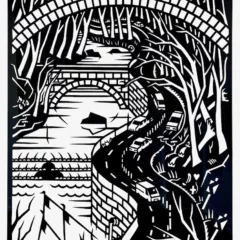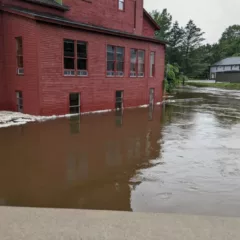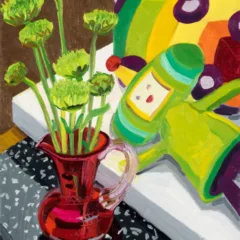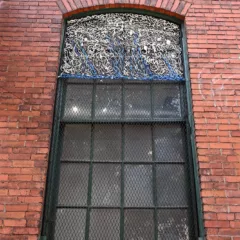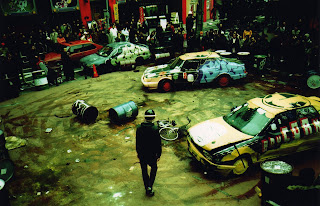
An artists’ demolition derby in a still from Aaron Rose’s Beautiful Losers (2008)
Lives of the Artists (ca. 2000)
I asked Tyler Kline to join me at the January 21 International House screening of two films on art/skateboarding cultures since he comes out of a Portland skateboarding and art scene of a younger generation than Aaron Rose’s Beautiful Losers (2008) and I thought he could provide footnotes (which he did). Rose’s film made for an interesting comparison with Ted Passon’s Space 1026 (2007) and told quite a different story of how the art and community developed. Rose portrayed Margaret Kilgallen, Mike Mills, Barry McGee, Phil Frost, Chris Johanson and Harmony Korine as self-described misfits no one would talk to in high school who were looking for love (or acceptance) so created intentionally-accessible art, Nike contracts and all, to attract their own community of appreciative viewers.

Thomas Campbell in a still from Aaron Rose’s Beautiful Losers.
Passon, on the other hand, portrayed Space 1026 as a group of art school grads who wanted to make art and hang out together and managed to find a way to do so. Passon’s short film was screened first and I suspect the local interest was the reason for the large and enthusiastic audience; the pairing made an entertaining program.
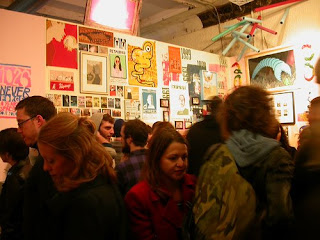
A November, 2007 event at Space 1026.
Contemplative Minimalism

Douglas Witmer’s installation, Joseph’s Coat at Philadelphia Cathedral.
Douglas Witmer’s work can be seen at Philadelphia Cathedral through Feb. 28. Joseph’s Coat is inspired by the story from Genesis; it consists of four large unstretched canvases which Witmer created for the space. They hang like tapestries below the stained glass windows on the North wall of the Cathedral. Along the opposite wall he’s installed five conventionally-stretched paintings and another on an adjacent wall. All push the meaning of geometry through their siting, emphasizing the contemplative quality of their reductive means. Surprisingly I found the paintings created independently to work better in the space than those created for it; their backgrounds of uneven gray washes pick up the neutral stucco of the Cathedral walls. Seeing them in the quiet, airy space with the sound of water dripping from a nearby baptismal font, it was easy to appreciate the play of the sharply-defined stripes against the background washes which bleed unevenly onto the canvases and occasionally seep onto the edges where they wrap around the stretchers.

Douglas Witmer’s work at Philadelphia Cathedral.
First Friday Footnotes
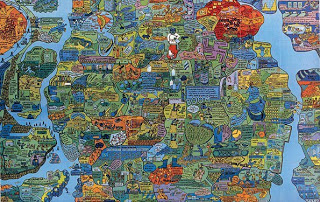
My first stop Friday night was Basekamp which is exhibiting An Atlas (through March 15) which they describe as a traveling exhibition of artists working with “radical cartography”—a practice that uses maps and mapping to promote social change (previously reviewed by Jacob Hellman here). Lots of reading and the expected left-wing critique of militarism, big business, etc., but interesting as far as it goes; I only hope visitors realize that these ideas have been around a long time. Oyvind Fahlstrom made anarchic political maps in the early 1970s and Mark Lombardi produced highly-researched charts of interlinked financial and political networks in the 1990s. There’s a huge amount of this material available on the web. For one example, see here.
The exhibition was an interesting bookend with Field Reports: Documents and Strategies from Land Arts of the American West, currently at Temple Gallery, which documents a workshop for Tyler students in the American Southwest as well as a Philadelphia-based mapping project, both run by Chris Taylor, director of Land Arts of the American West at Texas Tech University.
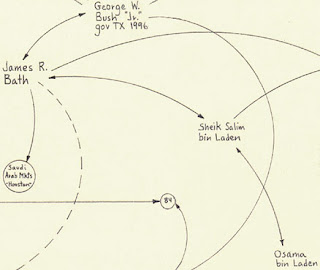
Mark Lombardi detail of George W. Bush, Harken Energy, and Jackson Stephens, ca. 1979-90 (5th Version) (1999).
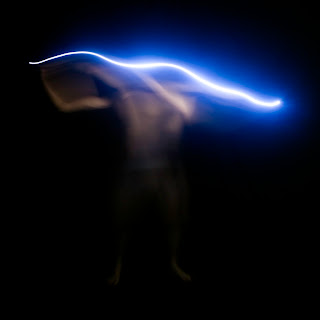
Benjamin Pierce still from Transfigurations, at Painted Bride.
Benjamin Pierce’s Transfiguration is on view at Painted Bride through March 15, courtesy of InLiquid.com. Pierce is showing several videos along with still images; all present visual interpretations of songs which Pierce sings a capella as he draws in light and reveals hints of his figure manipulating (dancing with) the light source. Pierce said he doesn’t consider the stills to be independent works; but I think he should reconsider. They are the more poetic, despite being still and silent.
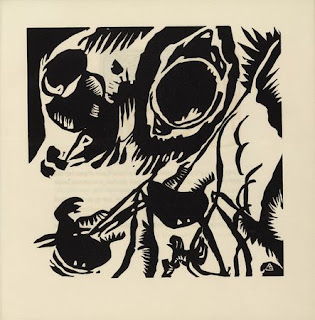
Vasily Kandinsky. Motif from Improvisation 25 (plate, folio 16) from Klänge (Sounds) by the artist. (1913). Woodcut from an illustrated book of fifty-six woodcuts, composition (irreg.): 8 9/16 x 8 11/16″. Photo courtesy of Museum of Modern Art.
The equivalence of music and visual imagery goes back to the beginning of abstraction, embodied in Kandinsky’s illustrated book, Klange (Sounds) of 1913 and running through Thomas Wilfred’s clavilux of the 1920s and abstract animated films by Oskar Fischinger and others. It was the subject of a 2005 exhibition, Visual Music, organized by the LA Museum of Contemporary Art. Pierce’s light drawing also recalls the famous Gijon Mili portrait of Picasso drawing with light.
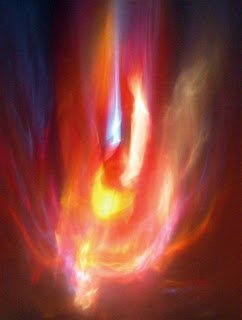
A Lumia image created by one of Thomas Wilfred’s color organs, which he called the clavilux.
Painted Bride’s next exhibition, Synasthesia (April 3-May 16), organized by Anabelle Rodriguez will explore the subject further.
Upcoming FLUX Fundraiser
I ran into Chris Golas at the Vox opening who gave me the hot-off-the-presses poster for the Feb. 19th Flux Fundraiser at Kung Fu Necktie. I imagine the details will be on the Flux website (though they aren’t up as I write).
And now for something completely different
I, can’t resist passing on a link forwarded by my friend, Barbara Tannenbaum, Director of Curatorial Affairs at the Akron Art Museum. It’s for a toy based on airport security checkpoints, and I can’t decide whether it’s the height (depth?) of decadence or just a reprise of the sort of mad paranoia that gave us grade school drills in the 1950s where we got under our desks and covered our heads in case we should face nuclear bombs. Anyway, check out the customer responses, some of which are clearly tongue in cheek.



